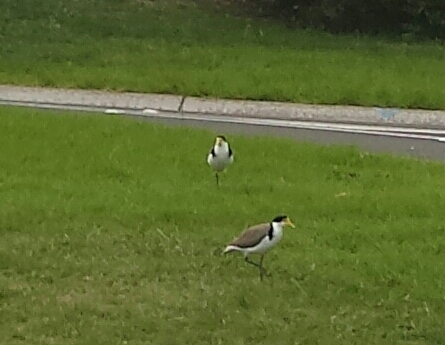This month’s bird post is dedicated by me to Liz, because (spoilers) it’s all about hating birds, and I laughed.
Hayley
When you are told as a child to keep away from a particular bird because it is aggressive and will attack you with the spurs on its wings if you get too close to it, that information tends to adhere itself to your mind like a pervasive horror story. An aggressive bird with SPURS on its WINGS. And they’re EVERYWHERE – parks, road verges, beaches. I distinctly remember them flocking to the local swimming pool that I swam at multiple times a week, stalking the grassy perimeters and peering malevolently at children with legs nicely suitable for stabbing (or so it seemed to me).

The masked lapwing, commonly known as the plover and indeed I intend to continue referring to them as plovers as that is how I’ve always known them, and I’m sure Michael will have a lot of indignation to expend on those like me who insist on calling birds common names that are completely incorrect genus designations, WHATEVER MICHAEL SOMETIMES SCIENCE IS JUST TOO OBDURATELY WORDY TO BEAR, is a terror bird in my mind. They are also, as I’ve discovered in researching this piece, a somewhat misrepresented boogeyman of a bird.
It’s been quite anticlimactic to learn that plovers are actually for the most part very wary of humans, despite their mostly blasé attitudes towards living in close quarters with them. Their breeding habits causes them to make their nests on the ground in open spaces, hence why you will see them hanging out in parks, on golf courses, and airports, the latter of which where they become a bird strike risk due to their tenacity in refusing to budge from their nesting area. Plovers have, out of necessity, developed an impressive array of diversionary tactics in luring away potential predators from their nests and chicks, including loud distracting calls, pretending to have only one leg in order to appear as an easier target, and, of course, swooping and attacking with their bright yellow wing spurs.
Yet these violent attacks are generally only last resorts, and more often directed at birds like ravens, and carnivores like domestic cats and dogs. Humans, it seems, very rarely experience the worst of plover attacks, and as much as I googled ‘Australian man savaged by enraged plovers’ I couldn’t find anything worse than folks getting a scare. Plovers are master bluffers, it appears.
Indeed, the more I read about plovers, my fear receded into a feeling of intense pity. While they can survive in close quarters with human habitation, the stresses of ground nesting combined with the dangers of suburban living results in many plover pairs never breeding successfully. Their eggs, which blend into lawn scrub so well, are often trampled by unwary feet, or blasted into nothingness by lawn mowers. Their willingness to live among humans simultaneously protects them from traditional predators, yet opens up so many other threats.

There are a pair of plovers that habitually hang around the front lawn of the house next door to my parents’. On the recent Easter weekend I went out to watch them (safely, from a distance). Apparently a breeding pair, they pootled about up and down the lawn, long yellow legs betraying their close relation to wading birds, fossicking in the grass for insects and making very occasional calls to each other, but otherwise silent as sentinels. I thought about childhood monsters, and of needlessly demonised animals, and I felt desperately sad.
2 feathers.
Michael
Steph has started us off pretty gently with this series, serving up a couple of lovable icons (galah and emu) for Hayley and me to rave over. You’d think she’d ease us into more controversial waters gently, throwing up something inoffensive we could be a bit less hyperbolic about (I’m thinking one of the honeyeaters perhaps). But no, she’s gone and assigned us Australia’s worst bird, the avian equivalent of The Room or Plan 9 from Outer Space without the camp ironic value.
I’ll acknowledge that I may be slightly biased here. You see I’ve never forgiven the masked lapwing for ruining my shot at a glorious cricketing career. I moved to Caloundra as a 10 year old and signed up for the local cricket team immediately, so I could impress potential school chums with my sporting prowess. As the new kid I was quickly assigned to fine leg – a dull outfield position where you don’t see a lot of action. Unless you’re playing at Russell Barker Memorial Park, where the lapwings conveniently nest near the fine leg boundary and then spend their Saturday mornings bombarding whichever noob has been sent into their territory. Needless to say the opposition scored many a boundary down fine leg way as I ducked and weaved, failing to pay any attention at all to the game going on around me. My sporting reputation never recovered.
So yes, this is personal, but I think I can still make my case. The masked lapwing is an aggressive, violent bird – don’t buy into Hayley’s nonsense about them being more scared of you than you are of them – these birds have leg spurs and they’re not afraid to use them. Read the 241 comments on this thread and tell me they’re harmless. Read some of the tips here: “avoid making eye contact or staring directly at the birds,” and: “don’t run away in a panic as this could encourage them.” These are not nice animals. When they’re not wounding adults and terrifying children, masked lapwings like to try to take down passenger aircraft – they even have their own fact sheet on the Australian Transport Safety Bureau website. These birds want to kill you and your family.
Their awful shrieking call combined with their vicious spurred dive-bombing and frankly monstrous faces are enough to have me rank them pretty low on my personal countdown of Australian birds, but the point that takes them right to the bottom is their breathtaking stupidity. Masked Lapwing chicks can’t fly when they first hatch and have to stumble around foraging for food until they get their wings up to full power. So what do their parents do? Build their nests on traffic islands, in the middle of roundabouts or by a busy airport runway, that’s what. And when I say ‘build their nests’, I mean scrape a tiny divot in the ground and dump some eggs in it. No wonder many pairs never successfully breed. I was going to give them a feather or two for their ability to fake an injury to lure predators away from their nests, but why evolve such a complex skill when you could just develop the ability to make a nest somewhere other than the local dog park? Idiots.
(ed: I found a video of them swooping and making their vicious noise PURELY FOR ACADEMIC INTEREST)
The final tipping point is their common name. These birds *are not plovers*. They are closely related to plovers, but you can tell that they’re not actual plovers because plovers are awesome. Plovers migrate from Siberia to Australia, plovers are cute, plovers do not viciously attack young children who are merely trying to make friends in a new town by joining the local sporting team. The masked lapwing is terrible even for a lapwing, lacking the cool mohawk that gives its European cousin so much cred.
0 feathers.
Bird: Masked Lapwing
Michael: 0 feathers
Hayley: 2 pity feathers

Loved this post, and not just because it fitted in with my thoughts about these pesky birds. I didn’t know they were likely to attack until I met them up at Rainbow Beach Caravan Park. I was on my way to the showers, thinking how nice it was to see some local wildlife. Then the local wildlife started to swoop me!! Until I read your post I didn’t know I wasn’t meant to run away — but I have to say, I would run again. 🙂
I think running is the only option – I found no solutions to their attacks while poking around on the web aside from getting around in sunglasses and bike helmets until breeding season has passed.
I’m with you, Michael. I had a shot at golf for a few weeks – I was an adult and still trying to make friends by pretending I could play sport – when some masked lapwings mistook my golf ball for their egg. The people I was trying to impress doubled over laughing while I did battle with the imbeciles. I can never forgive them.
I do agree in point, but I have 2 eating out of my hand and my Rainbow Lorikeet mimics them and they love being here. However when Spring comes!! I have video footage if anyone wants it.
We had a couple nest in our back yard last year. The lawn mower man had to refuse to do our lawn until they were gone as they full on attacked him-even with him pulling out his whipper snipper!
Rang the council who told us we just had to put up with them-which seems like a totally irresponsible attitude… We told them we had two young kids and they nested right in the path to their playground. Try telling young kids they can’t use their own playground!
We ended up moving the eggs-we needed to be able to use our backyard!
But they have recently returned-look like they’re scoping the place.
Haven’t nested yet but I’m scared that’s what they’re planning! You can see it in their ugly beedy little eyes. Nope there’s nothing nice about these birds!
Anyone got any ideas on how to stop them before they nest here?
Aargh, that sounds tough Lucy. I’ve got no idea what you can really do – as I understand it you’re really not supposed to interfere with the nests of native birds (it may even be illegal). Obviously living with the constant swooping is not really an option either – you might try getting in touch with Birdlife Australia (http://birdlife.org.au/) to see if they have any suggestions.